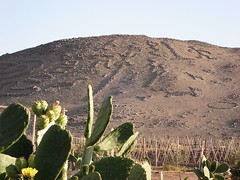The Chachapoya was one of the most mysterious and independent Pre-Incaic cultures. They lived in the isolated and hard valleys around Chachapoyas, capital of the Amazonas department. Iquitos seems so far from these places, but the immense rivers indicate us the direction towards the Amazon. The Chachapoya had been able to adapt to a hostile environment, building fortified cities (Kuelap) and necropolis of sarcophagi on the impressive slopes of the mountains (Karajia). The numerous mummies that during the last few years have been discovered, following the crescent interest for this civilization, tell us a history of warriors (“Guerreros de las Nubes”), skillful farmers and architects. Kuelap, the fortified citadel of the Chachapoya, is an example of their ability, second only to Machu Picchu for majesty, still nearly undiscovered. Kuelap was erected in about 700 d.C, on a steep slope at 3000 meters of altitude and still shows in all their greatness the defensive walls, hundreds of meters long and till 20 meters high. Manuél guide us in the Chachapoya world and their houses with circular plant and tapered thatch roof. Complex ceremonial rituals, planning the sacrifice of animals (llamas), venerated the figure of the god Sun.
Arica and Azapa valley
Arica is the northernmost seaport of Chile, a few kilometers from the border with Peru. Like all places at the border, the entire city is a huge market where goods are exchanged and where people argue passionately about the prices of agricultural products and textiles, surrounded by the pleasant smell of typical Andean food: empanadas, chicharrones and rocotos rellenos. A colorful and friendly crowd that accompanies the life of this bustling community. A few kilometers from Arica, inward and towards the Atacama desert, lies a green jewel, an oasis of palm, fruit and olive trees that unexpectedly grows on the sides of a small seasonal river, the San Jose. The special climate of this valley, that is called the Valley of Azapa, allows the cultivation of various fruits, vegetables and palm trees and the famous Azapa olives, typically purple colored, enabling the production of a special oil. Thanks to these special and favorable climatic conditions, the Azapa Valley has been inhabited by humans since ancient times. The Archaeological Museum of San Miguel Azapa tells the last 10000 years of history of this land, through the beautiful Tiwanaku dresses found in many cemeteries in the area and through the Chinchorro mummies, curled up in a final infinite reflection. The whole valley is surrounded by hills that were exploited by Andean civilizations as open books to tell their history through representations of rock art (petroglyphs) of extraordinary complexity and size. The Azapa valley is an incredible testimony of wealth and distinction that gives a clear idea of the cultural and religious and scientific knowledge of Andean peoples, from the past until nowadays.

